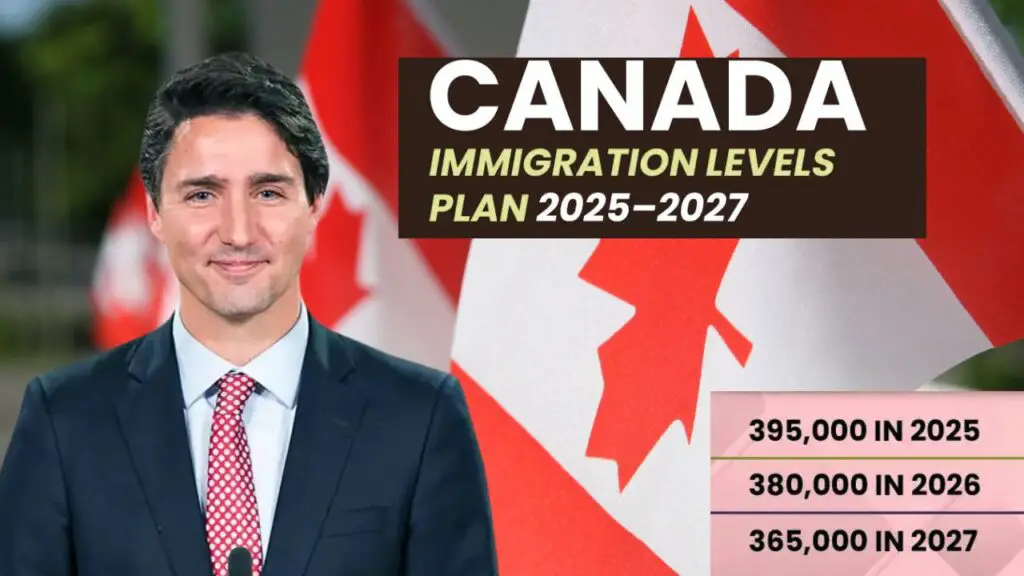The Canada Immigration Levels Plan for 2025-2027 outlines how many immigrants the country aims to welcome over the next three years. The goals for 2025 and 2026 remain ambitious as Canada continues to address labor shortages and promote growth in key sectors of the economy. For 2025, Canada plans to admit 500,000 new permanent residents, with the same target set for 2026. The number for 2027 will also be set at 500,000. These targets are spread across several immigration categories, including economic, family, refugee, and humanitarian classes.
Canada Immigration Levels Plan 2025-2027 Overview
| Immigration Class | 2025 | 2026 | 2027 |
|---|---|---|---|
| Economic | 301,250 | 301,250 | 301,250 |
| Family | 118,000 | 118,000 | 118,000 |
| Refugee | 72,750 | 72,750 | 72,750 |
| Humanitarian | 8,000 | 8,000 | 8,000 |
| Total | 500,000 | 500,000 | 500,000 |
Supplementary Information on Canada Immigration Levels Plan for 2025-2027
Canada Immigration Levels Plan for 2025-2027 also sets specific targets for various immigration programs designed to meet the country’s economic and social needs.
- Express Entry: 109,500 admissions in 2025
- Provincial Nominee Program (PNP): 81,000 admissions in 2025
- Family Reunification: 80,000 admissions in 2025
- Refugees and Protected Persons: 59,500 admissions in 2025
- Humanitarian and Other: 6,000 admissions in 2025
- Caregivers: 9,500 admissions in 2025
- Protected Temporary Residents: 24,000 admissions in 2025

Focus on French-Speaking Immigrants Outside Quebec
One key goal for the upcoming years is increasing the number of French-speaking permanent residents, particularly outside of Quebec. Canada is committed to increasing this proportion, aiming for 6% in 2024, 7% in 2025, and 8% in 2026. This initiative is essential for meeting labor market needs and ensuring the inclusion of French-speaking communities in Canada’s multicultural landscape.
Canada’s Immigration Priorities for Economic Growth
Immigrants play a crucial role in Canada’s labor market and economic expansion. The Canada Immigration Levels Plan for 2025-2027 addresses critical labor shortages in industries like healthcare, STEM, trades, transportation, and agriculture. By welcoming skilled workers, Canada is able to fill gaps in the workforce, contributing to its broader economic goals, including the transition to a green and digital economy.
Canada’s immigration strategy is designed not only to meet economic objectives but also to promote the well-being and successful integration of newcomers. Immigrants often bring unique skills and experiences that support local economies, whether through the labor force or by creating new businesses.
Family Reunification and Humanitarian Support
Family reunification continues to be a priority under the Immigration Levels Plan. The family class targets reflect Canada’s commitment to ensuring that families remain connected, facilitating the arrival of spouses, children, parents, and grandparents. This policy also allows newcomers to have the support of their families as they integrate into Canadian society.
Canada also remains dedicated to its humanitarian responsibilities. The refugee and humanitarian classes continue to provide support for those fleeing conflict or persecution, in line with Canada’s long-standing commitment to offer protection to vulnerable populations. The 2025-2027 Immigration Levels Plan ensures that Canada will continue to meet its obligations in this area.
How Does Canada Set Immigration Targets?
Each year, Canada’s immigration targets are set through a comprehensive process involving extensive consultations with key stakeholders, including provincial governments, employers, and immigrant advocacy groups. The government also considers Canada’s demographic trends, such as an aging population and low birth rates, when determining how many immigrants to admit.
Canada’s immigration policy is closely aligned with the country’s economic needs and international commitments. Immigration is a key solution to labor shortages, as well as a way to foster economic and social development. The plan is reviewed regularly to ensure it remains effective and flexible in response to changing global and domestic conditions.
How Can You Apply for Permanent Residency in Canada?
The application process for permanent residency varies depending on the immigration stream you choose. For 2025, Canada will continue to prioritize economic immigration through programs like Express Entry and the Provincial Nominee Program (PNP). If you are interested in immigrating to Canada in 2025, it’s important to stay informed about the latest changes to the immigration system and determine which programs you may be eligible for.
To help guide your decision-making, you can take the free Canada Immigration Quiz offered by Moving2Canada to see which immigration programs you qualify for. Registering for a Moving2Canada account will also provide access to personalized resources, including information on how to apply for permanent residency and exclusive offers from immigration experts.
Conclusion
The Canada Immigration Levels Plan for 2025-2027 reflects Canada’s commitment to welcoming newcomers who contribute to the nation’s economic success, family cohesion, and humanitarian obligations. With clear targets and a focus on economic growth, labor market needs, and social integration, this plan ensures that Canada remains a global leader in immigration. Whether you are considering applying for permanent residency or simply interested in the latest immigration trends, Canada’s levels plan offers a strategic pathway for the future of immigration in the country.
Stay updated on the latest immigration news and make informed decisions with the right tools and resources at your fingertips.

